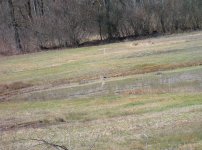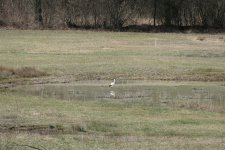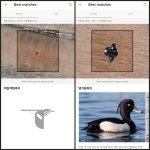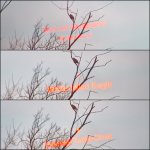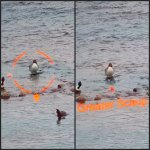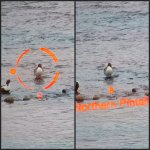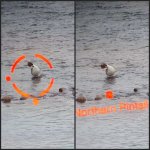The following personal findings reflect my experience using the Visio on a daily basis for over a month, doing literally hundreds of bird identifications with it.
1. Not a “quick and easy” device
Unless you are willing to invest some time and learn how to best use the Visio, you will likely experience many frustrating moments. That’s probably what happened to some internet reviewers who spent a few hours with the Visio and then concluded that it wasn’t really a useful device, since it didn’t reliably identify birds. Give it some practice and you will find that the Visio actually does the job it is designed to do quite well.
2. Don’t expect the impossible
As mentioned somewhere else, you as an experienced birder may be able to identify birds that are partially hidden in branches and behind leaves so that you can only see a small part of their body. For an algorithm, this is a greater challenge. Don’t expect the machine to be as “smart” as you. I have had surprisingly good results with birds almost invisible in or behind bushes, but not on a reliable basis, so don’t get mad if the Visio doesn’t give you a bird’s name or doesn’t even see a bird that you have spotted in the binocular but that is not really clearly visible.
3. Distance, distance, distance
Large birds (herons, storks, large birds of prey etc) can be identified by the Visio at distances well beyond 150m or more, both in flight and sitting still. The same is not true for small birds. Even 40m may be too far for tits or chiffchaffs. You will know it in advance when you look through the Visio and the shape of the bird in question by far does not fill the red circle it is supposed to fill. You may get an ID, but more likely you won’t. Too great a distance between me and the bird has been one of the main reasons of frustration for me, esp. if the bird had been well visible in the binocular of the Visio.
4. Turn on and leave on
As mentioned earlier, it is advisable to turn the Visio on when you actively start birding, and to leave it on. It will last several hours, perhaps most of the day, with a single battery charge. This ensures the GPS is active and bird IDs have a good chance of success.
5. Backlight is bad
IDs are much more successful with birds sitting on the ground or flying at your altitude or when observing against an earthen background than with birds sitting high up in a tree when the bright daylight is behind that tree. The same is true when you observe from a dark shelter with a low roof, watching out into the bright daylight or sunshine. Results are better if you are in the same lighting situation as the bird.
6. Focal length is not the main issue with the camera
I have experimented a bit, trying to find out what it would bring if the 260 mm of the Visio were increased to something like 370 mm (using a Lumix with Leica DC Vario objective). The difference isn’t that great when it comes to detail recognition (see pics attached). More focal length would be welcome in the Visio, but it would not drastically change things.
7. IS would be a clear improvement
Had the camera an image stabilization, many of those shots that I messed up when in a hurry, or when I was more jittery than usual, would have come out usable. Of course, this would further increase the size and weight of the Visio. So you may want to find other means to ensure stable shots (monopod, tripod, leaning against a tree, resting your elbows on something, etc.)
8. If you can get close enough and the bird is well visible, the Visio works almost 100%
You may get many birds identified even if the conditions mentioned in the manual are not fulfilled; but then the risk is high that the Visio will turn out a “no bird” result. However, if you get a clear shot at a bird that fills a large portion of the ID circle in the display, is well visible, the backlight is not too strong and you don’t jitter like hell, the success rate is close to 100%. When all those conditions were met, I did not have one single case of “no bird recognizable” with the Visio.
9. The rate of “no ID” is much higher than the rate of wrong IDs
That is my personal experience. I do get the occasional wrong ID that you would expect in situations where there are several bird species that look similar and ID would be tricky also for good birders. When I get a positive ID, it is usually right, or then I get a “no bird recognizable” much more frequently than a wrong ID.
10. The combination of binocular and camera is the greatest asset
Being able to observe and make a photo without having to put down the binocular is a fabulous thing. That alone (with the capability to later ID birds with the Merlin app) is much more important to me than the ability to ID a bird in the Visio right on the spot. Of course, the camera does by far not count as a “wildlife camera” with which you can shoot brilliant images of wildlife that you hang on your walls, but I think it is sufficient for recording and observation management tasks.
11. Other functions of the Visio
The “share discoveries” function of the Visio is useful when you are out with colleagues. Without a range measurement capability, the compass is of limited use to me. I haven’t used the mammal ID function; more useful is probably the possibility to ID butterflies and the like, but I haven’t used it much yet.
fwiw Canip
1. Not a “quick and easy” device
Unless you are willing to invest some time and learn how to best use the Visio, you will likely experience many frustrating moments. That’s probably what happened to some internet reviewers who spent a few hours with the Visio and then concluded that it wasn’t really a useful device, since it didn’t reliably identify birds. Give it some practice and you will find that the Visio actually does the job it is designed to do quite well.
2. Don’t expect the impossible
As mentioned somewhere else, you as an experienced birder may be able to identify birds that are partially hidden in branches and behind leaves so that you can only see a small part of their body. For an algorithm, this is a greater challenge. Don’t expect the machine to be as “smart” as you. I have had surprisingly good results with birds almost invisible in or behind bushes, but not on a reliable basis, so don’t get mad if the Visio doesn’t give you a bird’s name or doesn’t even see a bird that you have spotted in the binocular but that is not really clearly visible.
3. Distance, distance, distance
Large birds (herons, storks, large birds of prey etc) can be identified by the Visio at distances well beyond 150m or more, both in flight and sitting still. The same is not true for small birds. Even 40m may be too far for tits or chiffchaffs. You will know it in advance when you look through the Visio and the shape of the bird in question by far does not fill the red circle it is supposed to fill. You may get an ID, but more likely you won’t. Too great a distance between me and the bird has been one of the main reasons of frustration for me, esp. if the bird had been well visible in the binocular of the Visio.
4. Turn on and leave on
As mentioned earlier, it is advisable to turn the Visio on when you actively start birding, and to leave it on. It will last several hours, perhaps most of the day, with a single battery charge. This ensures the GPS is active and bird IDs have a good chance of success.
5. Backlight is bad
IDs are much more successful with birds sitting on the ground or flying at your altitude or when observing against an earthen background than with birds sitting high up in a tree when the bright daylight is behind that tree. The same is true when you observe from a dark shelter with a low roof, watching out into the bright daylight or sunshine. Results are better if you are in the same lighting situation as the bird.
6. Focal length is not the main issue with the camera
I have experimented a bit, trying to find out what it would bring if the 260 mm of the Visio were increased to something like 370 mm (using a Lumix with Leica DC Vario objective). The difference isn’t that great when it comes to detail recognition (see pics attached). More focal length would be welcome in the Visio, but it would not drastically change things.
7. IS would be a clear improvement
Had the camera an image stabilization, many of those shots that I messed up when in a hurry, or when I was more jittery than usual, would have come out usable. Of course, this would further increase the size and weight of the Visio. So you may want to find other means to ensure stable shots (monopod, tripod, leaning against a tree, resting your elbows on something, etc.)
8. If you can get close enough and the bird is well visible, the Visio works almost 100%
You may get many birds identified even if the conditions mentioned in the manual are not fulfilled; but then the risk is high that the Visio will turn out a “no bird” result. However, if you get a clear shot at a bird that fills a large portion of the ID circle in the display, is well visible, the backlight is not too strong and you don’t jitter like hell, the success rate is close to 100%. When all those conditions were met, I did not have one single case of “no bird recognizable” with the Visio.
9. The rate of “no ID” is much higher than the rate of wrong IDs
That is my personal experience. I do get the occasional wrong ID that you would expect in situations where there are several bird species that look similar and ID would be tricky also for good birders. When I get a positive ID, it is usually right, or then I get a “no bird recognizable” much more frequently than a wrong ID.
10. The combination of binocular and camera is the greatest asset
Being able to observe and make a photo without having to put down the binocular is a fabulous thing. That alone (with the capability to later ID birds with the Merlin app) is much more important to me than the ability to ID a bird in the Visio right on the spot. Of course, the camera does by far not count as a “wildlife camera” with which you can shoot brilliant images of wildlife that you hang on your walls, but I think it is sufficient for recording and observation management tasks.
11. Other functions of the Visio
The “share discoveries” function of the Visio is useful when you are out with colleagues. Without a range measurement capability, the compass is of limited use to me. I haven’t used the mammal ID function; more useful is probably the possibility to ID butterflies and the like, but I haven’t used it much yet.
fwiw Canip




